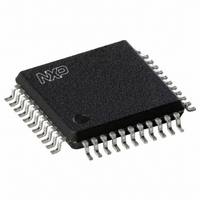TDA9874AH/V2,557 NXP Semiconductors, TDA9874AH/V2,557 Datasheet - Page 10

TDA9874AH/V2,557
Manufacturer Part Number
TDA9874AH/V2,557
Description
IC SOUND DEMOD/DECODE 44PQFP
Manufacturer
NXP Semiconductors
Type
Demodulatorr
Datasheet
1.TDA9874AHV2557.pdf
(68 pages)
Specifications of TDA9874AH/V2,557
Applications
TV
Mounting Type
Surface Mount
Package / Case
44-QFP
Lead Free Status / RoHS Status
Lead free / RoHS Compliant
Other names
935263704557
TDA9874AHB
TDA9874AHB
TDA9874AHB
TDA9874AHB
Available stocks
Company
Part Number
Manufacturer
Quantity
Price
Company:
Part Number:
TDA9874AH/V2,557
Manufacturer:
NXP Semiconductors
Quantity:
10 000
Philips Semiconductors
6.1.5
A 2-carrier stereo decoder recovers the left and right signal
channels from the demodulated sound carriers. Both the
European and Korean stereo systems are supported.
Automatic FM dematrixing is also supported, which means
that the FM sound mode identification (mono, stereo or
dual) switches the FM dematrix directly. No loop via the
microcontroller is needed.
For highly overmodulated signals, a high deviation mode
for monaural audio sound single carrier demodulation can
be selected.
NICAM decoding is still possible in high deviation mode.
6.1.6
The identification of the FM sound mode is performed by
AM synchronous demodulation of the pilot and
narrow-band detection of the identification frequencies.
The result is available via the I
can be made via the I
standards, and for three different time constants that
represent different trade-offs between speed and reliability
of identification. A pilot detector allows the control software
to identify an analog 2-carrier (A2) transmission within
approximately 0.1 s.
Automatic FM dematrixing, depending on the
identification, is possible.
6.1.7
The NICAM signal is transmitted in a DQPSK code at a bit
rate of 728 kbits/s. The NICAM demodulator performs
DQPSK demodulation and passes the resulting bitstream
and clock signal to the NICAM decoder and, for evaluation
purposes, to various pins.
A timing loop controls the frequency of the crystal oscillator
to lock the sampling instants to the symbol timing of the
NICAM data.
6.1.8
The device performs all decoding functions in accordance
with the “EBU NICAM 728 specification” . After locking to
the frame alignment word, the data is descrambled by
applying the defined pseudo-random binary sequence.
The device then synchronizes to the periodic frame flag
bit C0.
2000 Aug 04
Digital TV sound demodulator/decoder
FM
FM
NICAM
NICAM
DECODING
IDENTIFICATION
DEMODULATION
DECODING
2
C-bus for B/G, D/K and M
2
C-bus interface. A selection
10
The status of the NICAM decoder can be read out from the
NICAM status register by the user (see Section 7.4.2). The
OSB bit indicates that the decoder has locked to the
NICAM data. The VDSP bit indicates that the decoder has
locked to the NICAM data and that the data is valid sound
data. The C4 bit indicates that the sound conveyed by the
FM mono channel is identical to the sound conveyed by
the NICAM channel.
The error byte contains the number of sound sample errors
(resulting from parity checking) that occurred in the past
128 ms period. The Bit Error Rate (BER) can be calculated
using the following equation:
6.1.9
This function is enabled by setting bit AMUTE to logic 0
(see Section 7.3.12). Upper and lower error limits may be
defined by writing appropriate values to two registers in the
I
the number of errors in a 128 ms period exceeds the upper
error limit, the auto-mute function will switch the output
sound from NICAM to whatever sound is on the first sound
carrier (FM or AM) or to the analog mono input. When the
error count is smaller than the lower error limit, the NICAM
sound is restored.
The auto-mute function can be disabled by setting
bit AMUTE to logic 1. In this case clicks become audible
when the error count increases. The user will hear a signal
of degrading quality.
If no NICAM sound is received, the outputs are switched
from the NICAM channel to the 1st sound carrier.
A decision to enable or disable the auto-mute is taken by
the microprocessor based on an interpretation of the
application control bits C1, C2, C3 and C4, and possibly
any additional strategy implemented by the user in the
microcontroller software.
When the AM sound in NICAM L systems is demodulated
in the 1st sound IF and the audio signal connected to the
mono input of the TDA9874A, the controlling
microprocessor has to ensure switching from NICAM
reception to mono input, if auto-muting is desired. This can
be achieved by setting bit AMSEL = 1 and bit AMUTE = 0.
BER
2
C-bus section (see Sections 7.3.14 and 7.3.15). When
=
bit errors
---------------------- -
total bits
NICAM
AUTO
error byte 1.74 10
-
MUTE
Product specification
TDA9874A
–
5















